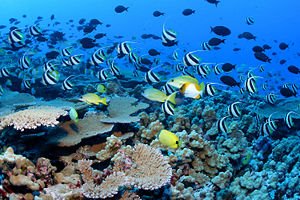- the biosphere is the layer around the Earth containing all living organisms. Chemicals elements essential to life are carbon, nitrogen, phosphorus, sulfur, etc... and they are all circulating around the Earth. Example: they get absorbed by plants; animals eat the plants; then carnivores eat herbivores, leading into a never ending cycle.
Biochemical Cycles
- The steps in the processes by which an element such as carbon passes through one environment (example: photosynthesis) to the next (example: fossil fuels) and eventually returns to it's original environment (example: photosynthesis).
- biological processes: cellular respiration and digestion
- geological processes: rock erosion and sedimentation
- chemical processes: combustion and photosynthesis.
Biomes
- large regions in the world with distinctive climates, wildlife and vegetation.
Aquatic biomes: salinity, turbidity (water clarity), temperature, direction/strength of current, presence of O2 (respiration) and CO2 (photosynthesis), solar energy (how much), nutrients (type and quantity), and water depth.

Terrestrial biomes: latitude, soil type, altitude, solar energy (how much), temperature, winds, precipiation, and proximity of bodies of water.

THE CYCLES:
Carbon Cycle
[1] photosynthesis: plants take CO2 out of the atmosphere
[2] ingestion: carbon exchange from plants to animals
[3] respiration: animals/plants exhale CO2 into the atmosphere
[4] decomposition of waste: organisms decompose waste producing CO2
[5] forest fires: combustion transforms carbon into CO2
[6] shells and skeletons: CO2 + Ca = CaCO3
[7] carbonate rock: shells and skeletons accumulate on the ocean floor to form carbonated rock (limestone)
[8] volcanic eruptions: carbonate rock release CO2 when melted by magma
[9] fossil fuels: carbon from dead organisms that fell into the ocean floor are buried by sediment changing into fossil fuels (coal and oil)

Nitrogen cycle
[1] nitrogen fixation: bacteria in the soil takes nitrogen from the atmosphere and convert it to nitrates, some ammonia reactions with hydrogen create ammonium
[2] nitrification: bacteria oxidizes ammonium to form nitrites, and other bacteria oxidizes nitrites to form nitrates
[3] nitrogen absorption by plants/animals: plants draw ammonium and nitrates, herbivores eat plants, and carnivores eat herbivores
[4] decomposition of waste: bacteria and fungi (mushrooms) break down nitrogen found in plant/animal waste producing nitrites, which dissolves to form ammonia
[5] denitrification: bacteria convert nitrites into nitrogen which returns into the atmosphere
BUT what the hell is nitrogen for?
- needed to make DNA
- amino acids which make up proteins (muscles)

No comments:
Post a Comment